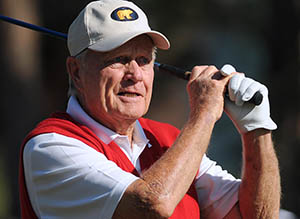If you’ve ever suffered from back pain, you’ll want to hear this.

Before having a miracle therapy, golf legend Jack Nicklaus couldn’t stand up for more than 10 minutes – let alone swing a gold club.
It wasn’t long ago that golf legend Jack Nicklaus almost lost the game he loved. After years of playing, debilitating back pain forced the Golden Bear off the golf course.
But thanks to life-changing stem cell therapy, Jack is back on the fairway swinging his clubs pain-free.
I’m not surprised at how well he’s doing. At the Sears Institute, we’ve successfully eliminated chronic pain in hundreds of patients using stem cells.
You know stem cells are the reserve of “replacement cells” you’re born with.
Your body can use them to replace any kind of cell that is damaged, old or dying. They allow your body to regenerate damaged tissue in any organ — from your brain to your heart to your liver.
They can even regrow discs in your back that have been damaged by years of degeneration – reducing pain and inflammation without the need for invasive and
dangerous spinal surgery.The studies back this up. In a recent clinical trial, 15 patients with degenerative disc disease were treated with stem cells harvested from their own fat tissue.1
Following the treatment, all 15 patients reported significant pain relief.
Another study, published in the journal Transplantation, followed 10 patients who failed to respond to traditional back pain therapies.
Researchers transplanted stem cells into their lower backs. After just six months, patients reported lumbar pain was reduced by a whopping 62% – while their ability to be more mobile increased 48%.2
I believe that stem cells are the future of modern medicine. They use what your own body provides to initiate your natural healing and repair system.
Stem cell therapy harvests healthy cells from your own body and reintroduces at the point of injury.
If you are interested in learning about the stem cell procedures I offer at the Sears Institute for Anti-Aging Medicine, please call my friendly staff at 561-784-7852. They are more than happy to answer all your questions.
Activate Your Stem Cells with Primal Nutrition
As you age, your stem cells slow down. Fatigue sets in. It’s like your stem cells are running on low batteries. But there are ways you can boost your stem cell production right at home. The best by far, is eating the Primal nutrients our ancestors ate.
- First, supercharge your stem cells with this missing food group. I call organ meat our missing food group. It’s packed with vitamin K2, which has been proven to reactivate “sleeping” adult stem cells. It gets them back to work keeping your bones and spine youthful and strong.
Your best food source of vitamin K2 is goose liver. Three and a half ounces of goose liver will provide 369 mcg of K2. Grass-fed meats, especially organ meat, chicken, beef, bacon and ham are also good sources.
It’s hard to get all you need from food. I suggest supplementing with 90 mcg of K2 a day. Look for vitamin K2 in the form of menaquinone-7. It’s much more bioactive than menaquinone-4.
- Then, dine on this forgotten superfood. Bone marrow is loaded with the stem cell activators your body needs to build, repair and maintain your bones, cartilage and spine. Our ancestors devoured it – and piles of animal bones broken open have been found in almost every ancient fire pit from the Paleolithic period.
I like roasting bone marrows for 20 minutes in a 450-degree oven. Then I toss them with a little virgin olive oil, fresh lemon juice and sea salt for a delicious delicacy.
To Your Good Health,
Al Sears, MD, CNS
References
1. Comella K, et al. Effects of the intradiscal implantation of stromal vascular fraction plus platelet rich plasma in patients with degenerative disc disease. J Transl Med. 2017; 15: 12.
2. Orozco L, Soler R, Morera C, Alberca M, Sanchez A, Garcia-Sancho J. Intervertebral disc repair by autologous mesenchymal bone marrow cells: a pilot study. Transplantation. 2011;92(7):822–828.
